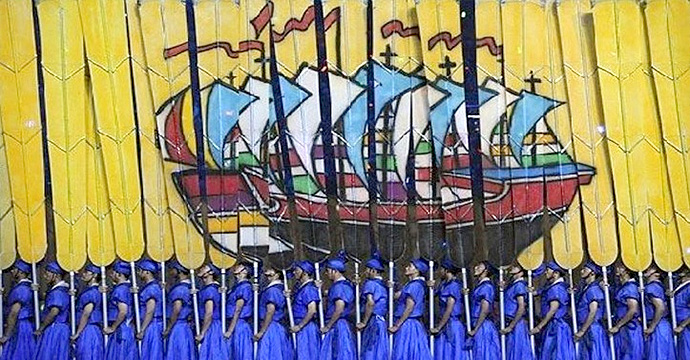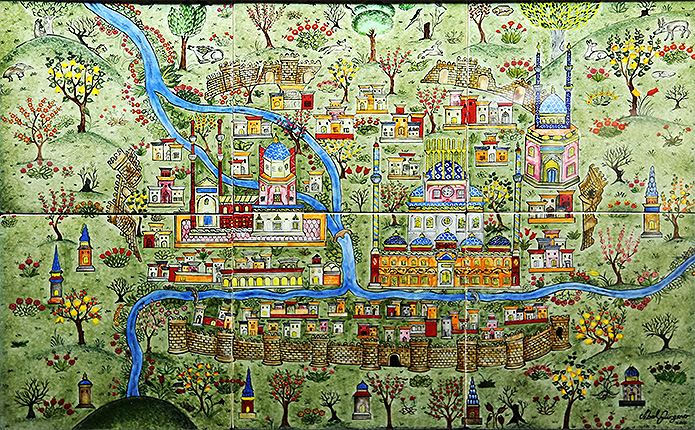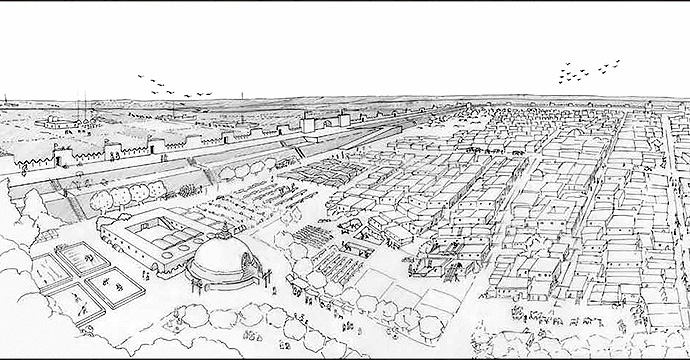

Mega Cities on the Silk Road
by Cem NizamogluPublished on: 25th August 2016
Throughout history, trade routes played a central role in the transfer of goods and exchange of ideas between different parts of the world. The historic Silk Roads, which were a network of trade routes across…
The Silk Roads
Throughout history, trade routes played a central role in the transfer of goods and exchange of ideas between different parts of the world. The historic Silk Roads, which were a network of trade routes across land and sea that connected the lands from China across Asia to the Meditteranean, connected civilisations and peoples from different cultures, religions and languages with each other allowing the exchange of ideas, technical know-how and friendsip, creating a legacy of connectedness and cultural appreciation.
Along the Silk Roads, many cities flourished across China, Central Asia, Arabia, India, Persia and modern day Turkey. Trade brought wealth and richness that enabled excellence in industrial process including printing, glass and paper making; medicine, philosophy, astronomy and agriculture. Cities became vibrant centres attracting intellectual polymaths and leaving a huge and fascinating mark on the consciousness of history.
Join us on a short journey to discover some of those amazing places:
1. Xi’an (Chang’an)

Potrail of one of Muslim Admiral Zheng He’s ships
Opening Ceremony for the 2008 Beijing Summer Olympics (Source)
Location: Xi’an is a major Chinese city. Formally known as Chang’an, it is an ancient imperial capital that saw the first Chinese missions leave to south-east Asia, central Asia and the Mediterranean marking the beginings of the Silk Road under the Han Dynasty in 141-87 BC (source).
Importance: From the 4th century onwards, Chang’an was the capital city of the Chinese Empire, and entered its greatest period of development under the Tang Dynasty (618-904) and became one of the most civilised cities in the world.
“At the height of its glory in the mid-eighth century, Chang’an was the most populous, cosmopolitan, and civilised city in the world” (Richard B. Mather, forward to Xiong).
 The Tang Dynasty West Market Museum is a privately-run museum in Xi’an and is situated on the original site of the 1000-year-old Chang’an City Tang Dynasty market (source). |
Significant Features: Chang’an was a trading hub that was a melting pot of people from different ethnic and religious backgrounds. Two important landmarks stood as witness to this glory:
- Chang’an Western Market: The city’s western market played an important role in the trade with the West along the Silk Roads to central Asia providing a hub for traders to sell and buy goods. Among the dominant figures in this era were Sogdian merchants from the region of Central Asia, who were vital agents in the transporting and trading of goods to China.
- Chang’an’s Great Mosque: The mosque still stands today and reflects how, uder the Tang (then later revived by the Ming), the city boasted an atmosphere of tolerance and was a key religious centre home not only to Buddhism and Taoism but also Zoroastrianism, Manichaeism, Nestorian Christianity and Islam.
Muslim Heritage: The Islamic Heritage in China: A General Survey by Anthony Garnaut


Chang’an’s Great Mosque’s (the Qingzhen Dasi) visible architecture dates from the late Ming period, although it was first built in 742. It’s located close to the western market that played an important role in th trade with the West along the Silk Roads (source).


Silk Road Cultural Street is situated at the original site of the Tang Dynasty West Market which thrived more than 1000 years ago in Chang’an City in the Tang Dynasty (source).
***
2. Samarkand
Location: An amazing city at the heart of Central Asia.. an important city on the Silk Roads strategically located between China and the Mediterranean.
Importance: For centuries it’d been a city of trade, renowned for its craft production and scholarly studies. Historical records show that from as early as the Han times (206 BC-220 AD), Samarkand’s merchants reached various places as far as China in order to trade precious metals, spices and cloth (Source). Then later, during the time of Tamerlane, Samarkand thrived as a great city when he made it his capital at the end of the 14th century.
Significant Features: Some of the significant features of the city came about at the times of two of its most prominent leaders; Tamerlane and Ulugbeg:
 Central high street: One of Tamerlane’s achievements was to build a central high-street with shops to encourage trade and the development of merchant economy as part of his plans of making the city a global centre. (Source).
Central high street: One of Tamerlane’s achievements was to build a central high-street with shops to encourage trade and the development of merchant economy as part of his plans of making the city a global centre. (Source).
- Samarkan’s Observatory: Tamerlan’s grandson Ulughbeg, who was a great scientist, developed Samarkand as a scientific and cultural centre. He was keen to surround himself with scholars to debate scientific questions with him. In 1424 he founded one of the greatest observatories in Muslim civilisation (Source). It was a monumental building equipped with a huge meridian which became the symbol of the observatory.
Famous Scholars: As a cultural and prosperous hub, Samarkandencouraged and attracted prominent scholars including 15th century Al-Kashi who devoted himself to astronomy and mathematics and was invited by Ulugbeg to join him at his school of learning in Samarkand together with some 60 other scientists like Qadi Zada who was also an accomplished astronomer and mathematician.
Muslim Heritage: The Scholars of Samarkand by Salah Zaimeche
***
3. Aleppo
Location: Strategically situated between the eastern mediterranean cost and the Euphrates Valley at the crossroads of several trade routes since the 2nd millennium B.C., Aleppo stands out as one of the key centers along the legendary Silk Roads.

Importance: Aleppo is one of the oldest continuously inhabited cities in the world, and has been an enlightened centre of trade and industry over the centuries.
Significant Features: Aleppo’s ancient city is home to some amazing monuments that bear witness to the social, cultural and economic exchanges that flourished in the city during the Golden Age of the Silk Roads from the 12th till the early 15th century (source). Those include:
- The Citadel and Mosque: Overseeing the city of Aleppo from the top of the hill is the prominent citadel which is an important landmark. The city is also home to a beautiful grand mosque originally built by an Umayyad Caliph in the 8th century and later altered several times.

- The Bazar: The renowned Bazar extends over 13 km long. It has been the core of the city’s economic and social life for hundreds of years. Up until recent history, each part of the Bazar bore the name of trades or products such as the Wool Souq, the Copper Souq, the Tailor’s Souq, the Spice Souq etc. Various Khans (caravanserais) like Khan Al Harir and Khan Al Sabun and hammams supported this bustling Bazar through offering services to traders and travellers from around the world.
Famous Scholars: Aleppo attracted many famous scholars, scientists and poets. Those include Al-Farabi, a scholar and philosopher keenly interested in the relation between logic and language; Al-Qifti; Youssef al-Sibti, Al-Mutanabi, Al-Hamadani. (source and here and here)
Muslim Heritage: Aleppo Citadel: Glimpses of the Past
***
4. Mosul
Location: Once a fourishing industrial and commercial city, Mosul, in today’s Northern Iraq and the north’s major center for trade, industry and communications, was once a thriving city on the Silk Roads.
10th-century Muslim geographer al-Muqaddasi, described Mosul as
 | the metropolis of this region. It is a splendid city, beautifully built; the climate is pleasant, the water healthy. Highly renowned, and of great antiquity, it is possessed of excellent markets and inns, and is inhabited by many personages of account, and learned men; nor does it lack a high authority in the Traditions, or a celebrated doctor of the law. From here come provisions for Baghdad, and thither go the caravans of al-Rihab. It has, besides, parks, specialities, excellent fruits, very fine baths, magnificent houses, and good meats: all in all the town is thriving.” |
 Importance: Under the Abbasid Muslim dynasty, Mosul became a major economic hub on the Silk Road. From that point forward, Mosul continued to develop incredibly advanced techniques in the arts and fine goods production. It has given its name to the fine textile “Muslin”.
Importance: Under the Abbasid Muslim dynasty, Mosul became a major economic hub on the Silk Road. From that point forward, Mosul continued to develop incredibly advanced techniques in the arts and fine goods production. It has given its name to the fine textile “Muslin”. The Blacas Ewer (629 AD), Shuja‘ b. Man‘a al-Mawsili. Jazira, Mosul. Photo © The Trustees of the British Museum, London |
Key features: Beyond the Muslin weaving, Mosul also became famous for its fine metalwork and painting styles.. Those were only a few of the key industries that this great industrial centre was home to. Others included:
- Crude Oil Production: Sources record crude oil production in Iraq where there were seepages on the eastern bank of the Tigris along the road to Mosul. Muslim travellers reported that it was produced on a large scale and was exported.
- Textile Production: Mosul has always been celebrated as a weaving centre producing the finest of textiles. It’s textiles were especially famed.
Famous Scholars: Those included the philosopher Bakr Kasim Al-Mawsili who authored an epistolary philosophical work entitled Fi’ al-Nafs; the 10th century astronomer and mathematician Al-Qabisi; and the infamous Opthalmologist Ammar Al-Mawsili.
Muslim Heritage: Mosul the Pearl of Northern Iraq
***
5. Merv
Location: Merv, was a major oasis-city in Central Asia, on the historical Silk Road, located near today’s Mary in Turkmenistan. In the early Islamic period, Merv was the capital of the province of Khorasan, and in the 12th century it was the largest city in the world.
Importance: Under the Abbasids, Merv continued to be the capital of the East. The great prosperity of Merv belongs to the period dating from the 8th to the 13th century. By the 11th century, Merv was a great commercial centre of the Oriental type with a bazaar, shops for artisans, money changers, goldsmiths, weavers, coppersmiths, and potters. It was an administrative and religious centre, containing mosques, madrasas, palaces, and other buildings.
Key features:
- Textile Production: One of Merv’s trademarks was its textile products, silk produced in abundance. The region was also famed for its fine cotton and exports of raw and manufactured products were sent to different lands. Merv was one of the great emporia of the caravan routes between western and eastern Asia, including to China.
Famous Scholars: Merv produced one of the earliest and greatest scientists of Muslim Civilisation including Ahmad ibn ‘Abdallah al-Marwazi (Marwazi means from Merv) who was an astronomer under the Caliphs al-Ma’mun; Al-Saghani, who was a mathematician and astronomer attached; and the greatest of all – al-Khazini who became a mathematical practitioner under the patronage of the Seljuk court.
Muslim Heritage: Merv: History, Science and Learning

Related Articles
- “Islam in China: Interview with Anthony Garnaut” by Kaleem Hussain
- “The Islamic Heritage in China: A General Survey” by Anthony Garnaut
- “Jewels of the Muslim Chinese Heritage” by Anthony Garnaut
- “The Legacy of Muslim Kung Fu Masters” by Anthony Garnaut
- “A Bibliography of the Islamic and Chinese Scientific Relationships in Classical Times” by FSTC
- “The Transfer of Science Between India, Europe and China via Muslim Heritage” by Charles Burnett
- “Zheng He – the Chinese Muslim Admiral” by Salah Zaimeche
- “The Back-Road Historic Mosques of China” by Sheila Blair, Jonathan Bloom and Nancy Steinhardt
- “1001 Inventions To Partner With China’s Biggest Science Festival” by 1001 Inventions






























No hay comentarios:
Publicar un comentario